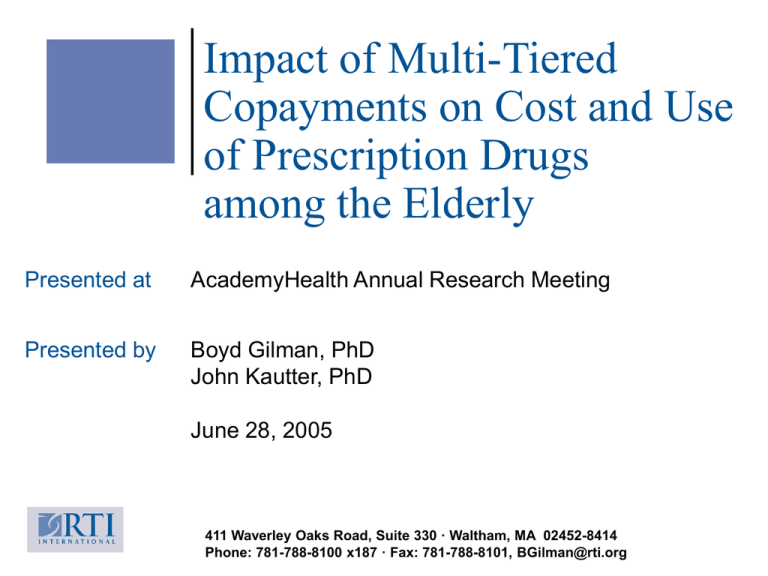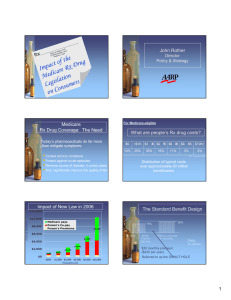Impact of Multi-Tiered Copayments on Cost and Use of Prescription Drugs
advertisement

Impact of Multi-Tiered Copayments on Cost and Use of Prescription Drugs among the Elderly Presented at AcademyHealth Annual Research Meeting Presented by Boyd Gilman, PhD John Kautter, PhD June 28, 2005 411 Waverley Oaks Road, Suite 330 · Waltham, MA 02452-8414 Phone: 781-788-8100 x187 · Fax: 781-788-8101, BGilman@rti.org Purpose of Study To evaluate the impact of multi-tiered copayments on cost and use of prescription drugs among the elderly in employersponsored health plans To assess the differential effects for enrollees who are taking drugs primarily for treatment of chronic conditions To decompose overall impact into a ‘price’ effect (due to higher copay for all drugs) and a ‘substitution’ effect (due to wider differential between copay for similar drugs) 2 Policy Motivation Medicare will start offering a prescription drug benefit (Part D) on January 1, 2006 Part D will be administered through private health plans that are allowed to set their own enrollee cost sharing rules as long as they: Are actuarially equivalent to standard benefit Do not discriminate against beneficiaries by increasing cost sharing of a drug used for a particular illness Employers may drop retiree coverage, forcing retirees to purchase Part D 3 Copayment Structures Apply fixed enrollee payment amounts to different types of drugs depending on payee preferences Tier 1 for generic drugs Tier 2 for preferred brand name drugs Tier 3 for non-preferred brand name drugs Tiered copayments are designed to: encourage generic substitution reduce use of drugs with low therapeutic value limit plan spending 4 Use of Tiered Rx Copayments among Retiree Health Plans According to KFF survey of employersponsored retiree health plans: 81% of firms use multi-tiered Rx copays Use of 3-tiered programs grew from 55% in 2003 to 58% in 2004 (2-tiered plans fell) Average Rx copays in 3-tiered plans are: $10 for generic $20 for preferred brand name $35 for non-preferred brand name 5 Current Literature Studies suggest that tiered copays may lower use of drugs Motheral & Fairman (2001) Joyce, Goldman & Escarce (2002, 2004) Huskamp (2003) Briesacher & Kamal-Bahl (2004) Study suggests that lower use may be caused by substitution of mail order prescriptions with longer days supply Thomas & Wallack (2003) 6 Data Medstat’s 2002 MarketScan databases: Medicare Supplemental and COB File Enrollment info for over 1 million enrollees in retiree health plans Rx claims for enrollees Medical claims for enrollees Benefit Plan Design File Extracts information on Rx and medical benefit features 7 Important Sample Caveats Benefit plan information extracted for only 27 health plans 27 health plans drawn from only 10 firms, with almost very little intra-firm variation in drug benefits Less than ½ enrollees are linkable to benefit plan design file Several important plan design features are reported as unknown High degree of correlation between plan design features Sample based on large, unionized, self-insured firms, and thus not representative of Medicare population 8 Classification of Plans by Drug Copayments Plan No. of Category Plans A 2 B 4 C 2 D 1 E 1 F 4 G 1 H 4 I 2 J 4 K 2 No. of Tiers 1 1 2 2 3 3 3 3 3 Coins. Coins. Copay Amount ($) Coins. Rate (%) BN BN Generic Pref. N/Pref. Generic BN 5 5 5 10 10 10 5 10 10 5 20 20 5 15 25 5 15 35 6 15 25 10 15 30 10 25 35 20 20 30 30 9 Enrollment and Drug Payments by Copayment Tier No. of % of Tier Enrollees Claimants Mean Drug Payments Total Enrollee % OOP 1 2 3 $2,531 $2,473 $2,028 318,512 496 69,188 90.5 80.2 88.9 $276 $298 $528 10.9 12.1 26.0 10 Basic Model Accessi = + 1 Demographicsi + 2 Health Statusi + 3 Plan Characteristicsi + 4 Medical Benefitsi + 5 Drug Benefitsi + εi 11 Model Outcomes Access outcomes Number of prescriptions filled – normalized by 30-days supply to account for potential mail-order substitution Total drug expenditures – measured as ingredient costs to account for differences in dispensing fees Other outcomes Enrollee drug payments Percent of prescriptions filled by generic drugs 12 Model Covariates Demographic Characteristics Age Gender Actively working Health Status Long-term disability HCC Risk score Plan Characteristics Managed care Medical Benefits Physician copay Drug Benefits Tier level (Copay amount) 13 Estimation Procedure Outcomes annualized to adjust for proportion of year enrolled Generalized linear model weighted by proportion of year enrolled Standard errors adjusted for within-firm correlation of error terms Payments estimated over claimants only (roughly 90% of enrollees submitted claim) Models run separately over claims for drugs used primarily to treat chronic conditions 14 Impact of 3-Tiered Copayment Program on Use and Cost of Rx All Enrollees Number of Rx Filled Total Payments ($) Enrollee Payments ($) Percent Filled with Generics (%) -7.2 *** -336 *** 185 *** 4.3 *** Enrollees with Chronic Condition -2.9 *** -121 *** 136 *** 6.0 *** Results from regression analysis. Omitted category = 1 & 2 tiered plans. 15 What’s driving these results: copay amounts or copay tiers? Copayment programs are designed to promote: Efficient use of drugs by raising the price of all drug equivalents (i.e., increasing copay amounts) Generic substitution by widening the price differential between drug equivalents (i.e., increasing copay differentials) 16 Price and Substitution Effects ‘Price effect’ measures the change in drug use following a change in marginal copays of drug equivalents. Likely to lead to higher total spending and lower drug use. ‘Substitution effect’ measures the change in drug use following a change in the copay differentials between drug equivalents. Likely to lead to lower total spending with little change on total use. 17 Decomposition Model Accessi = + 1-4 Other Covariatesi + 5 Copay Leveli + 6 Copay Differentiali + εi Copay level = lowest plan copay amount Copay differential = difference between highest and lowest plan copay 18 Decomposing the Price & Substitution Effects Substitution Price Effect Effect Percent change associated with: $5 increase in $5 increase in diff. betw. lowest lowest copay and highest amount copays Number of Rx Filled Total Payments ($) Enrollee Payments ($) Percent Filled with Generics (%) -8.8 ** -1.2 *** 154.2 *** -10.9 -6.1 *** -5.4 *** *** 18.5 *** 3.3 19 Conclusions More aggressive enrollee cost sharing is associated with: Fewer prescriptions filled Lower total payments and higher enrollee payments Higher proportion of Rx filled by generics Smaller reduction in drug use and greater generic substitution among those with chronic conditions Increasing copay differentials through multi-tiered program associated with: Greater generic substitution Smaller reduction in use of drugs 20 Policy Implications More aggressive enrollee cost sharing may promote efficient use of Rx, but may also create barriers to access Multi-tiered programs may be better than higher marginal copays for achieving efficiency without sacrificing access Responsiveness to price incentives and, thus, impact on access, may vary depending on type of condition treated Need to monitor impact of enrollee cost sharing programs on access and health outcomes in Part D plans 21

